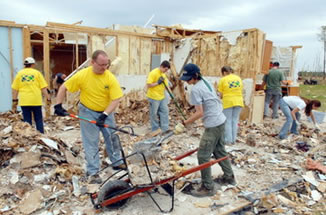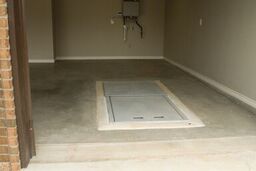Tornado Warning Signs You Need to Know
What Should I Do When I Get The Rebate
After you have received a rebate letter from your local planning commission you can then reach out to Ground Zero Storm Shelters to install your shelter.
- Your shelter must be installed by a member of a regulatory association like ATSA if want to receive a rebate – Ground Zero Shelters is a member of several!
- After the shelter is installed we will help you turn in all the required paperwork for the rebate.
If you have qualified for a rebate, order your shelter from Ground Zero today! You can also call us at 877-880-1351.
Do I Qualify For A Storm Shelter Rebate?
If you own or are in the process of buying a home, don't live in a flood plain, and your home is not a historical site, then you can qualify for a rebate on your property.
- Check with your local planning commission to see if they offer rebates in your county.
- Get the rebate application from your local planning commission.
- Fill out the rebate application and mail it in to the planning commission.
- The planning commission will process your information then send you a letter that says if you qualified for the rebate or not.
Have more questions? Contact us, or call us at 877-880-1351 and we can help you in this process.
Storm Shelter and Tornado Shelter Rebates and Grants
If you are in need of a storm shelter and budget is an issue, don’t give up! You may qualify for financial aid in the form of rebates, grants, Native American assistance or even FEMA funding. Take a look at your options below to find out if you qualify!
Storm Shelter Rebates & Grants
In Oklahoma everyone can go online and apply for the SoonerSafe Safe Room Rebate Program that draws twice a year (minimum) like a lottery all over Oklahoma for help getting tornado shelters. In disaster years they have been known to draw more than twice in one calendar year. Remember, you only get picked if you apply! There are no guarantees that you will get picked. Some have waited 5 years to get drawn and others have never been drawn.
Native American Storm Shelter Assistance
Most Oklahoma based tribes do offer assistance for storm shelters to be installed for their tribal members who are homeowners. If you are a member, you should contact the housing authority for your tribe and ask about storm shelter assistance.
You will then fill out a form with your information and wait until further notice if you have been accepted and the steps to follow thereafter, as well as your budget.
FEMA Storm Shelter Rebates & Funding
No matter where you live you can go to the www.FEMA.gov website and apply for assistance. Also if you live in an area prone to bad weather you can keep in touch with your city offices or local Emergency Management and they will advise you if they have any local, city or state funding for storm shelter assistance or if they know of any in the near future.
Life After a Tornado - How to Rebuild
 When a tornado strikes your community emotions run high and it’s hard to maintain a sense of normalcy after a disaster like this. Upon your first inspection of the damage, conditions might look as if the damage is irreparable. The stress of bearing such emotional AND financial burdens might seem too much for you to handle all at once. Starting over seems almost impossible...so much destruction! You might start asking yourself these questions:
When a tornado strikes your community emotions run high and it’s hard to maintain a sense of normalcy after a disaster like this. Upon your first inspection of the damage, conditions might look as if the damage is irreparable. The stress of bearing such emotional AND financial burdens might seem too much for you to handle all at once. Starting over seems almost impossible...so much destruction! You might start asking yourself these questions:
- Do I have money saved for an event like this?
- Will my insurance cover a tornado?
- Are there programs, organizations, family or friends that can help me?
Before you start beating yourself up, it is totally natural for you to ask if something could have been done to protect your home. Instead of feeling hopelessness, annoyance and bitterness towards the situation think about your future. When should the cleanup, repairs and rebuilding start? How do you even begin? Is it affordable to rebuild at this time? Don’t worry! There are ways to save time and money after a tornado has upset your life.
First of all, we are not trying to make this sound easy. It’s definitely never easy to rebuild your life. However; with determination and hard work this can and will be accomplished. Consider the questions that must be answered.
- Was there total or partial damage?
- Do all of your belongings have to be replaced?
- Should calculations of needs (today and in the future) be thought out?
After asking yourself these questions and answering them, it’s time to start the rebuild! Below are tips that will help tremendously in saving both time and money.
- Hire a contractor that is able to fund the beginning of the rebuild. It usually takes insurance companies a few months to send you the money.
- Insurance claims also cover your possessions. Take inventory of all non-salvageable items by taking pictures. You can even take pictures of your damaged foot items for food lost.
- If you are making new purchases to replace things that were lost – KEEP ALL OF YOUR RECEIPTS!
- Ask for advances from your insurance adjustor. Advances can be used for living expenses like clothes, food and toiletries.
- Check to see of your insurance policy covers storage for those items that were not damaged.
Also helpful are the tips below which you should think about in the days immediately after a tornado.
- Get a rough time line from your insurance agent on the next steps.
- Arrange cleaning or restoration service for clothes, house and property.
- Coordinate your work schedule if needed.
- Arrange schedules for child care providers if needed.
- Contact your utility companies.
- Contact your mortgage holder or landlord.
- Rent a postal box if mail needs to be redirected.
- Arrange for a security service to prevent looting if needed.
- Rent a storage unit for vehicles and possessions.
- Obtain boxes with folders to hold documents and receipts.
You can also check out our article series: How to Recover from Disaster for more information and resources.
Prepare a Tornado Disaster Recovery & Contact Plan
Tailored Disaster Recovery Plan for Oklahoma
In the heart of Tornado Alley, with primary focus on Oklahoma City and Tulsa, OK, the need for tornado preparedness isn't just a suggestion—it's a way of life. The key to managing through these severe storms is having a well-crafted tornado emergency preparedness strategy, including a disaster recovery plan and an emergency contact plan. Ground Zero Shelters is dedicated to helping you navigate these planning stages to ensure your family's safety.
Understanding the Need for a Disaster Recovery Plan
In areas like Oklahoma City and Tulsa, OK, where tornados are a frequent threat, the importance of tornado preparedness cannot be understated. One integral part of tornado emergency preparedness is the development of a robust disaster recovery plan. A tornado's devastation can be immense, leaving confusion and chaos in its wake. However, having a well-thought-out disaster recovery plan in place before a storm strikes can offer invaluable guidance and help restore order during such tumultuous times. A detailed disaster recovery plan will not only help you navigate the immediate post-tornado scenario, but it will also ensure that crucial needs such as shelter, food, and medical assistance are addressed. Your disaster recovery planning should include steps to assess the damage, reach out to insurance providers, find temporary accommodation if needed, and restore normalcy as much as possible. Remember, having such a plan in place isn't just about survival in the aftermath of the storm, but also about providing peace of mind in knowing you're prepared for whatever comes your way.
Creating Your Disaster Recovery Plan
A key cornerstone of any tornado preparedness strategy in Oklahoma City and Tulsa is having a secure shelter. Ground Zero Shelters provides a variety of tornado-resistant storm shelters, built to withstand the severe weather conditions specific to this region. These shelters form the first line of defense against tornados, offering a safe haven for you and your loved ones when the skies turn threatening. Tornado emergency preparedness extends beyond just the storm. Your disaster recovery plan must also account for the aftermath. This includes assessing your home’s condition, contacting your insurance provider, and arranging for temporary accommodations if needed. Each of these steps is crucial to regaining control and beginning the healing process after a tornado. Disaster recovery planning, while it may seem daunting, is made easier with comprehensive resources like our disaster recovery planning page. By arming yourself with the necessary knowledge and preparing in advance, you can turn a potential catastrophe into a manageable situation, ensuring the safety and well-being of your family throughout.
The Importance of an Emergency Contact Plan
As part of comprehensive tornado preparedness, creating an emergency contact plan is of utmost importance. Tornados in areas like Oklahoma City and Tulsa often bring chaos, making it possible for family members to get separated amidst the confusion. An emergency contact plan becomes a lifeline in such situations, allowing families to reconnect quickly and safely. Your tornado emergency preparedness strategy should include each family member having a pre-established list of contact numbers, preferably saved on their cell phones and a physical copy kept in their wallets. In addition to this, setting a predetermined meeting place that is safe and easily accessible is vital in case family members cannot return home. A comprehensive emergency contact plan not only ensures communication between family members during a disaster but also provides a sense of security and confidence when dealing with such challenging circumstances.
Making Your Emergency Contact Plan
As part of your tornado emergency preparedness, crafting an effective emergency contact plan is essential. Start by designating an out-of-town contact who can be reached by all family members. In scenarios where a tornado has hit Oklahoma City or Tulsa, it's often more reliable to send text messages as phone lines can get overloaded. Additionally, identify a safe, accessible location where your family can regroup if returning home isn't an option. Remember, when it comes to facing tornados, preparedness isn't just important—it's critical. Ground Zero Shelters is here to support you through this tornado preparedness process. We offer durable storm shelters engineered to protect you and your loved ones from the harshest weather conditions. But our support doesn't stop there—we also provide comprehensive resources to enhance your disaster recovery planning and ensure you're ready for anything. Don't let the storm catch you off guard. Plan ahead with Ground Zero Shelters. Explore our wide range of storm shelters and make use of our extensive tornado preparedness guides. Contact us today to secure your family's safety. Be prepared and gain the peace of mind you deserve when the storm hits.
What to Do Once a Tornado Has Passed

Understanding Tornado Aftermath with Ground Zero Shelters
Tornadoes are notorious for their raw power and the destruction they leave in their path, especially in areas like Oklahoma City and Tulsa, which are no strangers to these violent storms. Understanding what to do after a tornado is equally as crucial as preparing for one. Here, we at Ground Zero Shelters aim to guide you through the critical steps to ensure safety and recovery after a tornado in Oklahoma City and Tulsa.
Ensuring the Storm Has Truly Ended
After a tornado rips through, an unsettling quiet often ensues. This calm can create a false sense of security, leading some to believe that the danger has completely subsided. However, it's crucial not to be deceived by this deceptive stillness. Before even thinking of leaving the safety of your storm shelter, one must be absolutely certain that the storm has fully passed. This is where technology becomes an ally. A weather radio, which provides real-time updates, is an invaluable tool during these times. By tuning in, you can stay informed about the storm's progression and any subsequent alerts specific to your area. Remember, what happens after a tornado can sometimes be as hazardous as the tornado itself, given the debris and possible structural damage.
Checking for Injuries After a Tornado
After a tornado, it's super important to make sure everyone is okay. As soon as you know the storm is gone, look around and check if anyone is hurt. Some people might have small cuts or bruises. These can be taken care of with a simple first aid kit. But sometimes, people can get seriously hurt, and they might need a doctor or nurse to help.
Handling Serious Injuries
Big injuries like broken bones, deep cuts, or hits to the head need to be handled very carefully. If someone has a bad injury, don't move them unless something even more dangerous might happen, like if there's a live wire nearby. If you see someone is in real danger or very hurt, call 911 right away. It's a good idea to keep a list of emergency numbers close by just in case.
Dealing with Other Common Injuries
If someone can't breathe, and you know how to do CPR, you should help them. Another thing to watch out for is puncture wounds. These are cuts made by sharp things like nails. Even if they look small, they can become a big problem if not treated. Press on the wound to stop any bleeding and make sure to get it checked out. After a tornado, acting quickly and smartly is important to keep everyone safe.
Understanding Post-Tornado Dangers
After a tornado, familiar surroundings can quickly change into danger zones. While the storm might have passed, the aftermath can present numerous challenges that must be tackled cautiously. For example, downed power lines can pose significant risks. If you come across any, it's vital to stay far away and immediately report them to the local utility company. This ensures that the necessary repairs can be initiated and prevents potential accidents.
Re-entering Your Home Safely
Patience is key if your home has been hit and shows signs of damage. Always wait for a clear signal from emergency personnel before deciding to go back in. They are trained to assess the structural integrity of buildings and will provide guidance on when it's safe. Moreover, always be on the lookout for animals that might have sought shelter in your home during the storm. Some might be scared and could act out in self-defense.
Taking Precautions Inside
Even if your home seems untouched, there are still precautions to consider. For families fortunate enough to have their homes intact, keeping children and pets inside is recommended, away from potential hazards. If your pets need a breath of fresh air, always use a leash to ensure their safety. Power outages are common after storms, but it's crucial to prioritize safety when looking for light. Flashlights and lanterns are safer compared to candles, which could inadvertently lead to fires if not monitored closely. Always be prepared and prioritize safety above all.
Why Knowledge Matters
Living in places like Oklahoma City and Tulsa means you're in Tornado Alley. This is a spot where tornadoes happen a lot. So, knowing what to do after a tornado is super important. Even though we hope you never see a tornado up close, being ready and knowing what to do can keep you and your family safe.
Get Prepared with Us!
Don't wait for a tornado to surprise you. Make a plan, stay informed, and trust Ground Zero Shelters to help keep you safe. Contact us today to take the steps you need toward tornado preparedness.
|
< Previous
<< First |
Go to > 1 2 3 4 5 6 7 |
Next >
Last >> |








